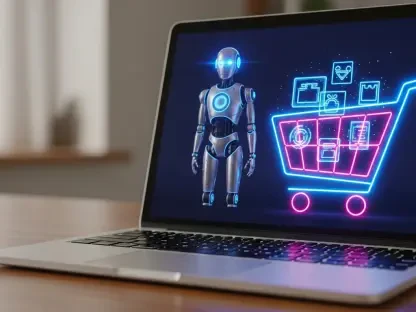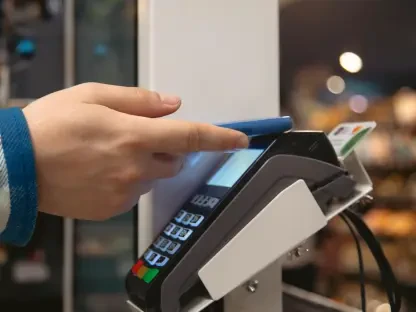The retail landscape is on the brink of a significant transformation, driven by the integration of digital and physical experiences. By 2025, retailers are expected to engage customers better, empower their employees, and optimize operations in a rapidly evolving marketplace. This article delves into the key trends that will define the future of shopping, highlighting the evolution of omnichannel retail, the shift from transactional to experiential retail, and the growing influence of digital twins.
The Evolution of Omnichannel Retail
Adaptive, Hyper-Personalized Experiences
Retailers are moving beyond merely integrating online and in-store experiences. By 2025, the focus will be on delivering adaptive, hyper-personalized experiences that cater to customer needs at every touchpoint. For instance, Target’s Drive Up service via Apple CarPlay allows hands-free navigation and real-time updates directly from a car’s display, transforming curbside pickup into a seamless part of the shopping journey. This innovative approach exemplifies how digital integration can streamline convenience and elevate customer satisfaction.
Hyper-personalization is a critical aspect of this trend. Retailers are harnessing data analytics to tailor AI-powered product recommendations and frontline tools that enable staff to provide personalized service. Platforms like YOOBIC assist in streamlining communication, training, and task management for frontline teams, ensuring every customer interaction is uniquely catered to, whether online or in-store. This data-driven customization not only enhances the shopping experience but also builds deeper connections between consumers and brands, fostering loyalty and repeat business.
Innovations in Omnichannel Strategies
Retailers like Zara are enhancing their omnichannel approach with real-time inventory tracking and a mobile-first model. Customers can reserve items online and collect them in-store via self-service kiosks or RFID-equipped fitting rooms. This fusion of digital precision and in-store convenience exemplifies a cohesive shopping experience that meets the modern consumer’s demand for efficiency and flexibility. Combining high tech with a hands-on approach, these strategies allow customers to enjoy the best of both worlds.
Moreover, omnichannel retail is rapidly evolving into a more adaptive system, where every touchpoint is interwoven with hyper-personalized experiences. For example, Zara’s mobile-first model and real-time inventory updates provide a fluid shopping journey that spans both digital and physical realms. Customers can enjoy the convenience of online reservations while utilizing self-service kiosks for quick pick-up or experiencing the ambiance of RFID-equipped fitting rooms. These advancements reflect the industry’s commitment to merging technology with user-centric design for a seamless retail experience.
Hyper-Personalization and Data Analytics
Hyper-personalization is a critical aspect of the modern retail ecosystem. By leveraging data analytics, retailers can offer AI-powered product recommendations and utilize frontline tools that enable staff to provide personalized service. This technology ensures that every customer interaction is meticulously catered to, whether online or in-store. Platforms like YOOBIC are particularly instrumental in streamlining communication, training, and task management for frontline teams. This level of personalization and efficiency not only enhances customer experiences but also builds stronger brand loyalty.
The emphasis on hyper-personalization in the retail sector is reflected in the strategic use of data analytics. Through advanced AI-powered recommendations, retailers can tailor their offerings to individual customer preferences. This approach, supported by platforms like YOOBIC, also enhances the capabilities of frontline teams by streamlining communication, training, and task management. As a result, every customer engagement becomes a uniquely catered experience, fostering a deeper connection between the consumer and the brand. This not only improves satisfaction but also encourages repeat business and long-term loyalty.
The Shift from Transactional to Experiential Retail
Immersive Customer Interactions
By 2025, physical stores are expected to evolve into immersive destinations that prioritize meaningful customer interactions. Flagship locations, such as Nike’s House of Innovation, blend augmented reality tools with personalized services to enhance shopper experiences. Pop-ups and temporary brand activations are also gaining popularity for creating novel and exclusive experiences that emotionally engage customers, thereby fostering stronger loyalty. These immersive experiences transform retail stores into dynamic spaces where customers can interact with brands in unique and memorable ways.
Furthermore, immersive interactions are transforming retail into a conducive environment that fosters deeper emotional connections and brand loyalty. These experiences, often facilitated through technology like augmented reality, allow customers to engage with products in more meaningful ways. Flagship stores, pop-ups, and other innovative retail spaces are becoming arenas for exclusive and novel interactions, making shopping more than just a transactional activity. By prioritizing these engaging environments, retailers are building stronger, lasting relationships with their customers.
Technology-Driven Experiences
Technology is integral to the evolution of retail from a transactional to an experiential model, offering interactive tools such as virtual try-ons, branded games, and digital avatars. These innovations provide new avenues for customers to explore products, enhancing their shopping experience. For instance, virtual reality can immerse customers in a brand’s story, creating a deeper connection through an engaging narrative. Gamified shopping experiences, on the other hand, inject a sense of wonder and fun, making the retail environment more exciting and enjoyable.
These technology-driven experiences are not only about novelty but also about creating meaningful interactions that enhance customer engagement. Virtual try-ons and digital avatars offer personalized experiences that allow customers to visualize products in unique ways. Gamification and interactive tools cater to a sense of exploration and play, creating memorable experiences that go beyond mere transactions. By integrating these advanced technologies, retailers are crafting environments that captivate and retain customers, ultimately driving loyalty and repeat business.
Empowering Frontline Teams
Frontline teams play a pivotal role in the transformation of retail from transactional to experiential. Equipped with real-time microlearning tools, knowledgeable and confident employees can elevate the customer experience. They manage augmented reality displays or share in-depth product knowledge, thereby enhancing the overall shopper experience. The result is a retail environment that doesn’t merely sell products but provides memorable experiences that keep customers coming back. This shift emphasizes the importance of well-trained and empowered employees in the new retail landscape.
Empowering frontline teams involves providing them with the right tools and training to manage new technologies and engage customers effectively. Platforms like YOOBIC facilitate this by streamlining communication, training, and task management. These tools ensure that employees are well-prepared to offer personalized service and handle advanced technology like AR displays. This not only enhances the customer experience but also boosts employee confidence and job satisfaction, leading to a more dynamic and engaging retail environment.
The Growing Influence of Digital Twins
Optimizing Operations with Digital Twins
Digital twins are virtual replicas of physical assets or environments that allow retailers to visualize, simulate, and optimize strategies in real-time without disrupting daily operations. Companies like Walmart and Ikea are leading the way in using digital twins for supply chain optimization and inventory management. These digital replicas help identify inefficiencies and refine processes before making real-world changes, enhancing overall operational efficiency. By leveraging this technology, retailers can optimize their operations and improve their response to market demands.
In addition to supply chain optimization, digital twins are also used for refining store layouts and testing product displays. This ensures the effective use of every square foot of retail space. By simulating shopper behavior, retailers can fine-tune store navigation, predict purchasing patterns, and create environments tailored to customer preferences. This not only improves operational efficiency but also enhances the overall shopping experience. Digital twins provide valuable insights that help retailers make informed decisions and implement changes that positively impact both operations and customer satisfaction.
Designing Customer-Centric Environments
High-end department stores are leveraging digital twins to design store layouts and test product displays, ensuring the effective use of every square foot. By simulating shopper behavior, retailers can refine store navigation, predict purchasing patterns, and craft environments tailored to customer preferences. These virtual simulations offer insights into bottlenecks and opportunities to enhance dwell time before implementing in-store changes. This approach ensures that every aspect of the retail environment is optimized to enhance customer experiences and boost sales.
The use of digital twins in designing customer-centric environments goes beyond mere layout optimization. These virtual replicas allow retailers to predict customer behavior and preferences, enabling them to create spaces that resonate with their target audience. By visualizing potential store changes before implementation, retailers can make data-driven decisions that enhance the shopping experience. This results in a more engaging and efficient retail space that meets the needs of modern consumers while maximizing operational effectiveness.
Implementing Insights with Frontline Teams
Executing insights from digital twins effectively depends on frontline teams’ ability to implement changes quickly and efficiently. Clear, actionable instructions ensure that store teams can reconfigure layouts or manage stock based on the information generated by digital twins. This seamless integration of digital and physical strategies enhances overall operational efficiency and customer satisfaction. Frontline teams play a crucial role in putting these insights into action, making sure that the benefits of digital twin technology are fully realized in the retail environment.
The success of digital twin implementations relies heavily on the expertise and readiness of frontline teams. By providing clear and actionable instructions, retailers can ensure that their staff is prepared to adapt to new configurations and stock management strategies. This not only streamlines operations but also enhances the customer experience by maintaining a well-organized and responsive retail environment. Empowered frontline teams are essential in bringing the insights and advantages of digital twin technology to life.
Empowering Employees for Retail Transformation
The Role of Empowered Employees
Transformation in retail is fundamentally driven by people. Empowered employees equipped with the right tools and training can deliver exceptional experiences, aligning strategy, technology, and frontline execution to meet evolving demands while fostering loyalty and growth. Retailers who invest in their employees’ development are better positioned to adapt to the rapidly changing market and provide superior customer service. This human-centric approach is vital for long-term success in the retail industry.
Empowering employees goes beyond providing basic training. It involves equipping them with advanced tools and continuous learning opportunities to manage new technologies and deliver personalized service. When employees feel confident and supported, they are more likely to engage positively with customers and contribute to a dynamic retail environment. This not only enhances the shopping experience but also builds a more resilient and adaptable workforce capable of meeting future challenges.
Tools and Training for Frontline Teams
Platforms like YOOBIC play a crucial role in empowering frontline teams by streamlining communication, training, and task management. These tools ensure that employees are well-prepared to provide personalized service and manage new technologies, ultimately enhancing the customer experience. By investing in such platforms, retailers can create a more efficient and cohesive workforce, capable of delivering consistent and high-quality service across all touchpoints. This investment in human capital is essential for driving retail transformation and achieving long-term success.
Moreover, the use of platforms like YOOBIC helps in creating a more connected and engaged workforce. Real-time communication and training ensure that employees are always up-to-date with the latest tools and techniques, enabling them to perform their roles more effectively. This continuous support and development foster a culture of excellence and innovation within the retail environment. As a result, employees are more likely to take ownership of their roles and contribute positively to the overall success of the business.
Aligning Strategy and Execution
The retail industry is poised to undergo a major transformation as digital and physical experiences blend seamlessly. By 2025, retailers aim to enhance customer engagement, empower their workforce, and streamline operations in an increasingly dynamic marketplace. This shift involves several key trends shaping the future of shopping.
First is the evolution of omnichannel retail, where stores integrate online and offline platforms to provide a cohesive shopping experience. This approach ensures consistency across different customer touchpoints, whether they’re browsing online or visiting a brick-and-mortar location.
Second is the transition from transactional to experiential retail. Retailers are moving away from simply selling products to creating memorable experiences that foster deeper connections with customers. This can include interactive in-store events, personalized services, and immersive digital experiences that make shopping more engaging and enjoyable.
Lastly, the rise of digital twins is playing a crucial role. These virtual replicas of physical stores allow retailers to simulate and optimize store layouts, inventory management, and customer interactions, ultimately leading to improved efficiency and customer satisfaction.









